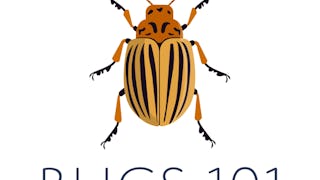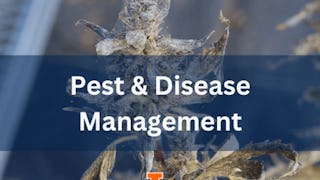This English language course covers the science and sociology of insects as food and feed. Increasing media, investment, and public policy attention has been given over the years to the role insects may play in the future of food. Can eating insects really save the world from famine and environmental destruction? Are there health costs or benefits to adding insects to the diet? Will all people accept insects as food? Can we feed them to livestock? Should we be promoting edible insects at all, and if so, how best do we do it? What species will we eat and how shall we raise them? This class examines all aspects of the edible insects question, with students taught a broad but thorough overview of the field and asked to consider questions in class about what role they think insects will play in their own food futures, and why they think this way.



(32 reviews)
Recommended experience
What you'll learn
Think critically about why we eat certain things and not others, and the cultural influences that shape these views.
Describe and evaluate the arguments driving the edible insect movement.
Know examples of edible insects and other insect products worldwide.
Be able to apply Diffusion of Innovations theory to food-related innovations.
Understand in what directions the edible insect field is going, and perhaps decide what role they want to play in it.
Details to know

Add to your LinkedIn profile
6 assignments
See how employees at top companies are mastering in-demand skills


Earn a career certificate
Add this credential to your LinkedIn profile, resume, or CV
Share it on social media and in your performance review

There are 8 modules in this course
Hello, everyone! Welcome to Edible Insects! This English language course covers the science and sociology of insects as food and feed. Increasing media, investment, and public policy attention has been given over the years to the role insects may play in the future of food. Can eating insects really save the world from famine and environmental destruction? Are there health costs or benefits to adding insects to the diet? Will all people accept insects as food? Can we feed them to livestock? Should we be promoting edible insects at all, and if so, how best do we do it? What species will we eat and how shall we raise them? This class examines all aspects of edible insects, with students taught a broad but thorough overview of the field and asked to consider questions in class about what role they think insects will play in their own food futures, and why they think this way.
What's included
1 video1 reading
This lecture has students think deeply about what influences our ideas of “food,” challenging their previously held assumptions. Why do we eat some animals and not others? Why some parts of animals and not others? We will then introduce the concept of eating insects specifically, and a basic overview of Diffusion of Innovations theory, which will be applied throughout the course when discussing why insect eating has or has not been adopted in different parts of the world.
What's included
12 videos2 readings1 assignment1 discussion prompt
This lecture provides a broad overview of traditional and modern edible insects from around the world, and how these are changing with time.
What's included
12 videos1 reading1 assignment
In this lecture, students will learn and analyze the environmentalist argument in favor of eating insect protein, and debate the ethical issues of insect consumption. Students will also learn about the nutrition and safety of edible insects. By the end, students should be able to make a fact-based decision on whether eating insects is acceptable for them, and justify their choice.
What's included
12 videos2 readings1 assignment2 discussion prompts
This lecture broadly covers techniques for rearing some of the most commonly farmed edible insects, both for human food and as animal feed, and the socioeconomic reasons why farming technology is so important.
What's included
12 videos2 readings1 assignment
This lecture looks at post-production aspects of edible insects. How are insects prepared, cooked, processed, and packaged? Who are the target market for edible insects, and what are the best marketing strategies to reach them? Finally, the lecture looks at the legal aspects of edible insects.
What's included
12 videos1 reading1 assignment2 discussion prompts
This lecture covers insect products outside of directly eating insects as food. This includes both edible and inedible insect products, insect services, and insects as medicine. By the end, students will appreciate the diverse roles insects play in human industry.
What's included
12 videos1 assignment2 discussion prompts
What's included
2 readings2 peer reviews
Instructor

Offered by
Recommended if you're interested in Environmental Science and Sustainability


University of Alberta


Princeton University


Utrecht University


University of Illinois Urbana-Champaign
Why people choose Coursera for their career




Learner reviews
32 reviews
- 5 stars
90.62%
- 4 stars
6.25%
- 3 stars
0%
- 2 stars
0%
- 1 star
3.12%
Showing 3 of 32
Reviewed on Jul 24, 2024
Interesting and in depth discussion of edible insects throughout the whole world
Reviewed on Sep 26, 2023
Excellent course! Thank you! Well written and delivered; it was enlightening, interesting and entertaining!
Reviewed on Oct 31, 2024
This is so far the best course I attended online, all the data were pooled and presented in a brief and simple manner

Open new doors with Coursera Plus
Unlimited access to 10,000+ world-class courses, hands-on projects, and job-ready certificate programs - all included in your subscription
Advance your career with an online degree
Earn a degree from world-class universities - 100% online
Join over 3,400 global companies that choose Coursera for Business
Upskill your employees to excel in the digital economy
Frequently asked questions
Access to lectures and assignments depends on your type of enrollment. If you take a course in audit mode, you will be able to see most course materials for free. To access graded assignments and to earn a Certificate, you will need to purchase the Certificate experience, during or after your audit. If you don't see the audit option:
The course may not offer an audit option. You can try a Free Trial instead, or apply for Financial Aid.
The course may offer 'Full Course, No Certificate' instead. This option lets you see all course materials, submit required assessments, and get a final grade. This also means that you will not be able to purchase a Certificate experience.
When you purchase a Certificate you get access to all course materials, including graded assignments. Upon completing the course, your electronic Certificate will be added to your Accomplishments page - from there, you can print your Certificate or add it to your LinkedIn profile. If you only want to read and view the course content, you can audit the course for free.
You will be eligible for a full refund until two weeks after your payment date, or (for courses that have just launched) until two weeks after the first session of the course begins, whichever is later. You cannot receive a refund once you’ve earned a Course Certificate, even if you complete the course within the two-week refund period. See our full refund policy.
More questions
Financial aid available,


